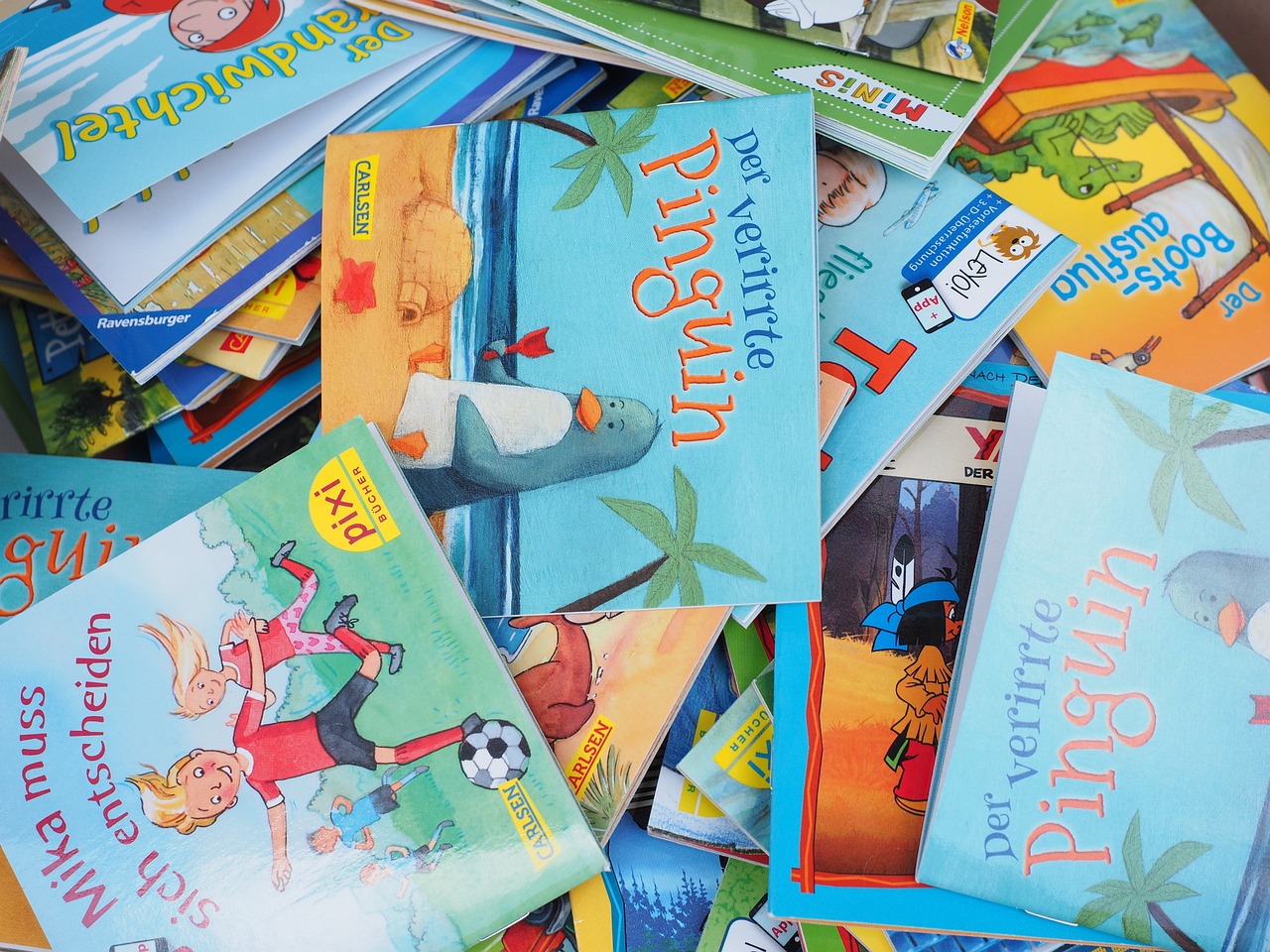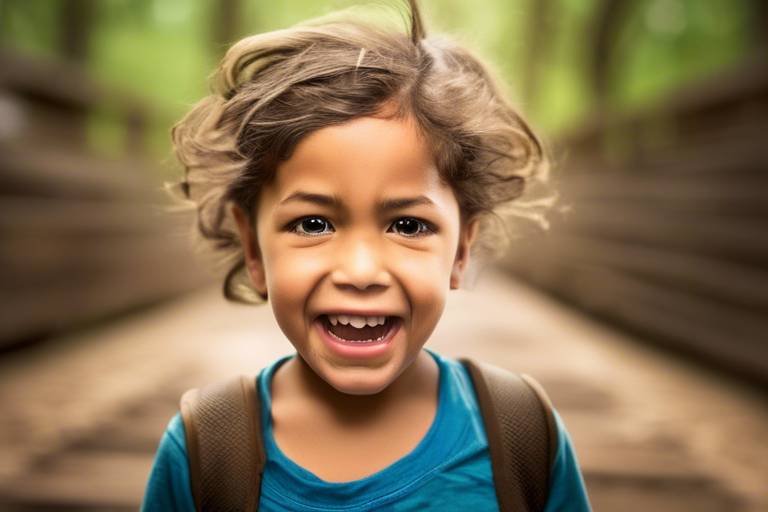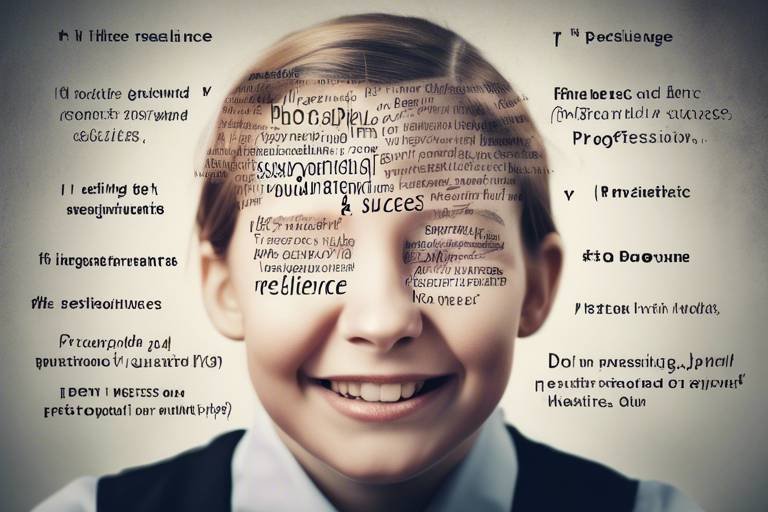Fostering Resilience in Kids - A Guide for Educators
In today’s fast-paced world, where challenges seem to pop up like weeds in a garden, the ability to bounce back from adversity is more crucial than ever. This article explores various strategies educators can implement to nurture resilience in children, enabling them to overcome challenges and thrive both academically and personally. Resilience isn’t just about getting through tough times; it’s about growing stronger because of them. Imagine resilience as a muscle— the more you work it out, the stronger it becomes. So, how can we help our kids build this vital muscle?
Resilience is the ability to bounce back from adversity. But what does that really mean for our kids? It’s about more than just surviving tough situations; it’s about thriving despite them. Resilient children are like rubber bands—they stretch, they bend, but they don’t break. They learn to cope with stress, adapt to change, and face challenges head-on. This section will discuss the importance of resilience in children's development and how it impacts their emotional and social well-being. When children develop resilience, they not only improve their academic performance but also enhance their social skills, emotional regulation, and overall mental health. It’s a win-win situation!
Identifying traits that characterize resilient children can help educators foster these qualities. Resilience is not a one-size-fits-all trait but rather a collection of attributes that can be nurtured over time. Some key traits include:
- Optimism: Resilient children tend to have a positive outlook on life, believing that they can overcome difficulties.
- Adaptability: They are flexible and open to change, which allows them to navigate through life’s ups and downs.
- Perseverance: Resilient kids don’t give up easily; they keep pushing through challenges.
By focusing on these traits, educators can create an environment that encourages students to develop resilience. It’s like planting seeds in a garden; with the right care and nurturing, those seeds will grow into strong, thriving plants.
Creating a nurturing classroom atmosphere is essential for resilience. A supportive environment acts as a safety net, allowing children to take risks and learn from their mistakes. This part will cover strategies for establishing trust, safety, and encouragement among students. For instance, educators can foster open communication, where students feel free to express their thoughts and feelings without fear of judgment. When kids know they are in a safe space, they are more likely to embrace challenges and learn from them.
Positive peer interactions contribute significantly to resilience. When children have friends who support and uplift them, they are more likely to bounce back from setbacks. This subsection will explore ways to promote teamwork and friendship among students. Activities like group projects or team-building exercises can help students forge strong bonds, creating a sense of community in the classroom. After all, it’s easier to face challenges when you know you have a support system behind you.
Feedback plays a crucial role in resilience. It’s not just about telling students what they did wrong; it’s about guiding them toward improvement. This section will discuss how to deliver constructive criticism that encourages growth and learning. Instead of saying, “You failed this test,” try, “Let’s look at what you can do differently next time.” This approach not only helps students learn from their mistakes but also instills a sense of hope and the belief that they can improve.
Equipping children with coping strategies is vital for resilience. This part will outline effective techniques educators can teach to help students manage stress and challenges. Techniques such as deep breathing, visualization, and positive self-talk can empower students to handle difficult situations. Think of these coping skills as tools in a toolbox; the more tools they have, the better equipped they are to tackle life’s challenges.
Incorporating resilience-building activities into lesson plans can enhance learning. This section will suggest practical ways to weave resilience into various subjects and projects. For example, in a literature class, discussing characters who face adversity can spark conversations about real-life challenges. In science, experiments that require trial and error can teach students the value of perseverance. By making resilience a part of the curriculum, educators can help students see that it’s not just a skill for school but a life skill.
A growth mindset fosters resilience by encouraging students to view challenges as opportunities. This subsection will detail methods to cultivate this mindset in the classroom. By praising effort over outcome, educators can help students understand that mistakes are a natural part of learning. It’s about shifting the narrative from “I can’t do this” to “I can’t do this yet.” This simple change in language can make a world of difference!
Mindfulness can enhance emotional regulation and resilience. This section will explore mindfulness techniques educators can implement to help students stay grounded and focused. Practices such as meditation, mindful breathing, or even simple stretching exercises can help students manage stress and improve their concentration. Think of mindfulness as a mental reset button; it allows students to pause, reflect, and approach challenges with a clearer mind.
Q: What is resilience?
A: Resilience is the ability to bounce back from difficulties and adapt to challenges effectively.
Q: How can educators foster resilience in children?
A: By creating a supportive environment, teaching coping skills, and promoting positive relationships.
Q: Why is resilience important for children?
A: Resilience helps children navigate life's challenges, enhances their emotional well-being, and improves academic performance.

Understanding Resilience
Resilience is more than just a buzzword; it's a vital skill that allows children to navigate the ups and downs of life effectively. Think of resilience as a rubber band: when stretched, it can return to its original shape. Similarly, resilient children can bounce back from setbacks, learn from their experiences, and continue to grow. This ability to recover is essential, especially in today's fast-paced world where challenges can come from various directions—be it academic pressures, social dynamics, or personal issues.
The importance of resilience in children's development cannot be overstated. It impacts not only their academic performance but also their emotional and social well-being. Children who possess resilience are more likely to face challenges head-on, adapt to new situations, and maintain a positive attitude, even when the going gets tough. Research shows that resilient children tend to have better mental health, improved relationships with peers, and a greater sense of overall happiness. They are like trees that bend in the wind but do not break; they learn to sway with life's storms rather than succumb to them.
So, how do we nurture this resilience in our classrooms? It's essential to understand that resilience is not a trait that some children are born with while others are not. Instead, it is a set of skills and attitudes that can be developed over time. Educators play a crucial role in this process by creating an environment that encourages risk-taking, fosters a sense of belonging, and provides opportunities for children to learn from their mistakes.
In essence, resilience is about equipping children with the tools they need to face life's challenges. It involves teaching them to recognize their emotions, understand their reactions, and develop coping strategies. By doing so, we empower them to not only survive difficult situations but to thrive in the face of adversity.
To summarize, here are a few key points about resilience:
- Definition: The ability to bounce back from adversity.
- Importance: Critical for emotional and social well-being.
- Development: A skill that can be cultivated through supportive environments.
- Empowerment: Equipping children with coping strategies enhances their ability to face challenges.

Key Traits of Resilient Children
Resilience isn’t just a buzzword; it’s a vital quality that can help children navigate the ups and downs of life. Think of resilience as a rubber band: it stretches but doesn’t break. So, what are the key traits that make some kids bounce back from challenges while others struggle? Understanding these traits can empower educators to nurture resilience in their students, creating a classroom atmosphere where every child can thrive.
One of the most prominent traits of resilient children is optimism. These kids tend to have a positive outlook on life, believing that they can overcome obstacles. They see failures not as dead ends but as opportunities for learning and growth. This optimistic perspective is crucial because it helps children maintain their motivation even when faced with difficulties. It’s like having a light in a dark tunnel; they know there’s an exit ahead.
Another essential trait is adaptability. Resilient children can adjust to new situations and challenges without losing their footing. They are like chameleons, changing their approach as needed while remaining true to themselves. This adaptability is particularly important in our ever-changing world, where flexibility can mean the difference between success and failure. Educators can encourage adaptability by presenting students with various challenges and scenarios, allowing them to practice adjusting their strategies.
Perseverance is yet another key trait that characterizes resilient children. These kids are not easily discouraged; they keep pushing forward, even when the going gets tough. Imagine a marathon runner who, despite fatigue, keeps putting one foot in front of the other. To foster perseverance, educators can set up tasks that require sustained effort, celebrating small victories along the way to keep students motivated.
In addition to these traits, resilient children often possess strong problem-solving skills. They approach challenges methodically, breaking them down into manageable parts and brainstorming solutions. This skill is invaluable, as it empowers children to tackle difficulties head-on rather than shying away from them. Educators can enhance problem-solving skills by incorporating critical thinking exercises into their curriculum, encouraging students to think creatively and analytically.
Moreover, resilient children tend to have a strong sense of self-efficacy. They believe in their abilities and trust that they can influence their own outcomes. This trait is closely tied to their optimism and perseverance, as it reinforces their belief that effort leads to success. Teachers can help build self-efficacy by providing opportunities for students to set and achieve personal goals, thus reinforcing their belief in their capabilities.
Lastly, it's crucial to recognize the role of emotional regulation in resilience. Children who can manage their emotions effectively are better equipped to handle stress and adversity. They can recognize their feelings, understand them, and respond appropriately. Educators can support emotional regulation by teaching mindfulness techniques and creating a safe space for children to express their feelings openly.
In summary, the key traits of resilient children—optimism, adaptability, perseverance, problem-solving skills, self-efficacy, and emotional regulation—are interconnected and can be nurtured through intentional teaching practices. By focusing on these traits, educators can help their students develop the resilience necessary to face life's challenges with confidence and strength.
- What is resilience in children? Resilience is the ability of children to bounce back from challenges, adapt to adversity, and continue to thrive emotionally and academically.
- How can educators foster resilience? Educators can foster resilience by creating a supportive environment, encouraging positive relationships, providing constructive feedback, and teaching coping skills.
- What are some activities to promote resilience in the classroom? Activities can include team-building exercises, problem-solving challenges, and mindfulness practices.

Building a Supportive Environment
Creating a nurturing classroom atmosphere is not just a nice-to-have; it’s a necessity for fostering resilience in children. Think about it: a supportive environment is like a safety net that allows kids to take risks and learn from their experiences without the fear of falling too hard. When children feel safe and valued, they’re more likely to engage, explore, and bounce back from setbacks. So, how can educators cultivate this kind of environment? Let’s dive into some practical strategies!
First and foremost, establishing trust is essential. Children need to know that their classroom is a safe space where they can express themselves without judgment. This can be achieved through regular check-ins, where teachers ask students about their feelings and experiences. For instance, a simple “How was your day?” can open the door to deeper conversations. Additionally, teachers can model vulnerability by sharing their own challenges, showing students that everyone faces difficulties and that it’s okay to talk about them.
Another critical aspect of building a supportive environment is creating a sense of belonging. When students feel like they are part of a community, they are more likely to support one another. Activities such as team-building exercises or collaborative projects can help foster these connections. For example, consider implementing group discussions where students can share their thoughts and experiences on a topic. This not only promotes open communication but also encourages empathy among peers.
Furthermore, it’s vital to maintain an atmosphere of encouragement. Celebrate small victories, whether it’s mastering a new concept or showing kindness to a classmate. Positive reinforcement can go a long way in boosting a child’s confidence and resilience. Teachers can adopt a practice of recognizing effort over outcome, reinforcing the idea that trying hard is just as important as achieving results. This can be done through verbal praise, reward systems, or even a simple acknowledgment in front of the class.
Finally, establishing clear boundaries and expectations is crucial for creating a supportive environment. Children thrive when they know what is expected of them and what they can expect from their peers and teachers. Setting clear rules and guidelines helps students feel more secure and allows them to focus on learning rather than navigating uncertainty. To make this process engaging, educators can involve students in creating class rules, giving them a sense of ownership over their environment.
In summary, building a supportive environment is a multifaceted endeavor that requires intentionality and care. By fostering trust, encouraging connections, celebrating efforts, and establishing clear expectations, educators can create a classroom atmosphere where resilience can flourish. Remember, a supportive environment doesn’t just benefit individual students; it enriches the entire classroom community, paving the way for collective growth and success.
- What are some signs that a child may need more support in building resilience? Look for signs of anxiety, withdrawal, or difficulty coping with challenges. These can indicate that a child needs additional support to develop resilience.
- How can I encourage resilience in children outside of the classroom? Encourage open communication at home, provide opportunities for problem-solving, and model resilience in your own life.
- Are there specific activities that can help build resilience in children? Yes! Activities such as role-playing, team sports, and group projects can all promote resilience by encouraging collaboration and problem-solving.

Encouraging Positive Relationships
Building positive relationships among students is crucial for fostering resilience in the classroom. Think of the classroom as a garden; just as plants need sunlight and water to thrive, children need supportive connections to grow emotionally and socially. When students feel connected to their peers, they are more likely to engage, take risks, and bounce back from setbacks. But how can educators cultivate these vital relationships?
First and foremost, creating a collaborative environment is essential. Encourage group activities where students can work together on projects or problem-solving tasks. This not only helps them learn to rely on one another but also teaches them the value of teamwork. For instance, consider implementing group discussions or peer review sessions. These activities foster communication and help students understand different perspectives, which is key to building empathy.
Moreover, it's important to recognize and celebrate diversity within the classroom. Each student brings unique experiences and backgrounds that can enrich the learning environment. By embracing these differences, educators can help students appreciate one another and form deeper connections. Activities that promote sharing personal stories or cultural traditions can be particularly effective.
Another strategy is to set up peer mentoring programs. Pairing older students with younger ones can create a sense of responsibility and belonging. Mentors can guide their peers through challenges, fostering an environment where asking for help is seen as a strength rather than a weakness. This not only helps the mentees but also builds confidence in the mentors, reinforcing their own resilience.
Lastly, educators should model positive relationships themselves. When teachers demonstrate respect, kindness, and understanding, students are likely to mirror these behaviors. Creating a classroom culture where everyone feels valued and heard will lay the groundwork for students to develop their own positive relationships. Remember, it’s not just about the academic curriculum; it's about nurturing the whole child.
In summary, encouraging positive relationships among students is a multifaceted approach that involves collaboration, appreciation of diversity, peer support, and modeling healthy interactions. By investing time and effort into these strategies, educators can cultivate a resilient classroom community where every student feels empowered to thrive.
- Why are positive relationships important for resilience?
Positive relationships provide emotional support, help students feel secure, and encourage them to take risks, all of which are essential for building resilience. - How can I promote teamwork in my classroom?
Incorporate group projects, peer reviews, and collaborative problem-solving activities to encourage teamwork and foster strong relationships among students. - What role does diversity play in building relationships?
Embracing diversity helps students appreciate different perspectives and backgrounds, which can deepen their connections with one another. - How can I model positive relationships as an educator?
Demonstrate respect, kindness, and understanding in your interactions with students, and create a classroom culture where everyone feels valued.

Providing Constructive Feedback
Providing constructive feedback is an essential component of fostering resilience in children. It’s not just about pointing out what went wrong; it’s about guiding students toward improvement and encouraging them to learn from their mistakes. Think of feedback as a roadmap for growth, where every turn and bump in the road offers a lesson. When educators deliver feedback effectively, they can help students develop a positive attitude towards challenges, seeing them as opportunities rather than obstacles.
One of the most effective ways to provide constructive feedback is to use the "sandwich" approach. This method involves starting with a positive comment, followed by the area for improvement, and then concluding with another positive note. For example, you might say, "I really liked how you organized your thoughts in this essay. However, to strengthen your argument, you could provide more evidence. Overall, your writing style is engaging and keeps the reader interested!" This approach not only softens the blow of criticism but also reinforces what the student is doing well, which is crucial for nurturing their confidence.
Additionally, it’s important to be specific in your feedback. Instead of saying, "You need to work on this," you could say, "I noticed that your last paragraph could use more detail. Can you think of examples that support your main idea?" This specificity helps students understand exactly what they need to do to improve and encourages them to take ownership of their learning process. When they see that feedback is aimed at helping them grow, they are more likely to embrace it rather than feel discouraged.
Moreover, encouraging a dialogue around feedback can significantly enhance its effectiveness. Rather than simply delivering comments and moving on, educators should invite students to discuss their thoughts on the feedback they receive. This could involve asking questions like, "What do you think about this suggestion?" or "How do you feel about your progress?" Such conversations not only clarify expectations but also empower students to take an active role in their learning journey.
Finally, it’s crucial to remind students that making mistakes is a natural part of the learning process. By framing feedback within the context of growth and resilience, educators can help children understand that setbacks are not failures but stepping stones to success. In fact, a study by the American Psychological Association found that students who perceive feedback as constructive are more likely to persist through challenges and develop a resilient mindset.
In conclusion, providing constructive feedback is about more than just improving academic performance; it’s about building resilient individuals who can navigate the ups and downs of life with confidence. By creating a supportive environment where feedback is seen as a tool for growth, educators can empower students to embrace challenges, learn from their experiences, and ultimately thrive.
- What is constructive feedback? Constructive feedback is specific, actionable advice aimed at helping someone improve their performance or understanding.
- Why is feedback important for resilience? Feedback helps students understand their strengths and areas for improvement, fostering a growth mindset and encouraging them to learn from mistakes.
- How can I make feedback more effective? Be specific, use a positive tone, involve the student in the conversation, and frame feedback as a part of the learning process.

Teaching Coping Skills
Teaching coping skills is like giving children a toolbox filled with essential tools to navigate the ups and downs of life. Just as a carpenter needs the right tools to build a sturdy house, children need coping strategies to construct a resilient mindset. In a world where challenges are inevitable, equipping students with these skills can significantly impact their ability to manage stress and overcome obstacles. So, how can educators effectively teach these vital skills? Let's dive into some practical approaches!
First and foremost, it's important to create a safe space where students feel comfortable expressing their emotions. When children know they can share their feelings without fear of judgment, they're more likely to open up about their struggles. This openness is crucial for teaching coping skills, as it allows educators to address specific challenges students face, whether it's anxiety about exams or difficulties in friendships.
One effective method is to incorporate role-playing activities into the classroom. By simulating real-life scenarios, students can practice their responses to stressful situations in a controlled environment. For instance, if a student is struggling with peer pressure, educators can set up a role-play where one student acts as the peer and another practices saying "no" assertively. This hands-on experience not only builds confidence but also reinforces the idea that they can handle tough situations effectively.
Additionally, teaching children about mindfulness techniques can greatly enhance their coping skills. Mindfulness helps students stay grounded and present, allowing them to manage overwhelming emotions. Simple practices like deep breathing exercises or guided imagery can be introduced during class. For example, educators can lead a short session where students close their eyes and focus on their breath, picturing a calm and peaceful place. This practice not only reduces stress but also empowers students to tap into these techniques whenever they feel anxious or overwhelmed.
Another crucial aspect of teaching coping skills is helping students develop a problem-solving mindset. When faced with challenges, children often feel stuck and unsure of how to proceed. Educators can guide them through a structured problem-solving process, encouraging them to identify the problem, brainstorm possible solutions, evaluate the options, and choose the best course of action. This approach not only fosters resilience but also instills a sense of agency, showing students that they have the power to effect change in their lives.
Moreover, incorporating storytelling into lessons can be a powerful way to teach coping skills. Sharing stories of characters who face adversity and overcome it can inspire students and provide relatable examples of resilience in action. After reading a story, educators can facilitate discussions about the characters' coping strategies, prompting students to reflect on how they might apply similar techniques in their own lives.
Finally, it's essential to recognize and celebrate small victories. When students successfully apply a coping skill, whether it's managing their stress before a test or resolving a conflict with a friend, acknowledging their efforts reinforces positive behavior. This could be as simple as a shout-out in class or a sticker chart that tracks their progress. Celebrating these moments not only boosts their confidence but also encourages them to continue using the coping skills they've learned.
In conclusion, teaching coping skills is a fundamental aspect of fostering resilience in children. By creating a supportive environment, utilizing role-playing, introducing mindfulness practices, promoting problem-solving, using storytelling, and celebrating successes, educators can equip students with the tools they need to navigate life's challenges. Remember, just like any skill, coping strategies take practice, and with the right guidance, children can learn to bounce back stronger than ever!
- What are coping skills? Coping skills are strategies that help individuals manage stress and navigate challenges effectively.
- Why are coping skills important for children? They enable children to handle adversity, reduce anxiety, and foster emotional well-being.
- How can I teach coping skills at home? Encourage open communication, model healthy coping strategies, and create a supportive environment for your child.
- Can coping skills be taught in schools? Absolutely! Educators can incorporate various activities and discussions into the curriculum to promote these skills.

Integrating Resilience into the Curriculum
Integrating resilience into the curriculum is not just about adding a few lessons here and there; it’s about weaving resilience into the very fabric of education. Imagine a classroom where every subject not only teaches academic skills but also equips students with the tools to handle life’s ups and downs. This holistic approach can transform the way children learn and grow, fostering a generation of resilient individuals ready to tackle challenges head-on.
One effective way to integrate resilience is through project-based learning. By engaging students in real-world problems, educators can create opportunities for students to practice resilience in a safe environment. For instance, a science project could involve overcoming obstacles, like a failed experiment, which teaches students that failure is a part of the learning process. This hands-on experience can reinforce the idea that setbacks are not the end but rather stepping stones to success.
Another strategy is to incorporate literature that highlights resilience. Books and stories featuring characters who face adversity and emerge stronger can inspire students. Discussing these narratives in class can lead to meaningful conversations about personal experiences and coping strategies. For example, reading about a character who perseveres through challenges can encourage students to reflect on their own lives and recognize their strengths.
Moreover, it’s essential to create opportunities for self-reflection within the curriculum. Activities such as journaling or group discussions can help students process their thoughts and feelings. By encouraging them to articulate their experiences, educators can foster a deeper understanding of resilience. This practice not only enhances emotional intelligence but also builds a supportive community where students feel safe to share and learn from one another.
In addition, resilience can be integrated into various subjects through interdisciplinary approaches. For instance, in a history lesson, students can explore how historical figures overcame significant challenges. This not only makes history more engaging but also allows students to draw parallels between their own lives and the lives of those who have triumphed over adversity. Mathematics can also play a role; problem-solving in math can mirror the problem-solving required in life, teaching students to approach challenges with a positive mindset.
To effectively implement this integration, educators should consider professional development opportunities focused on resilience. Workshops and training sessions can equip teachers with the necessary skills and strategies to foster resilience in their classrooms. When educators are well-prepared, they can create a more impactful learning environment that nurtures resilience in every student.
In summary, integrating resilience into the curriculum is a multifaceted endeavor that requires creativity, collaboration, and commitment. By embedding resilience into academic subjects and fostering a supportive classroom environment, educators can help students not only excel academically but also thrive personally. After all, the goal of education is not just to impart knowledge but to prepare students for the unpredictability of life.
- What is resilience in children? Resilience is the ability of children to bounce back from setbacks, adapt to challenges, and keep going despite difficulties.
- How can educators assess resilience in students? Educators can assess resilience through observations, discussions, and reflective activities that reveal how students cope with challenges.
- Can resilience be taught? Yes, resilience can be taught through specific strategies, activities, and a supportive classroom environment that encourages growth and learning.
- What role do parents play in fostering resilience? Parents can support resilience by encouraging independence, modeling positive coping strategies, and maintaining open lines of communication with their children.

Promoting Growth Mindset
In today's fast-paced world, fostering a growth mindset in students is more crucial than ever. But what exactly does it mean? A growth mindset is the belief that abilities and intelligence can be developed through dedication and hard work. This perspective is essential as it creates a love for learning and resilience, which are vital for great accomplishments. Imagine a child who sees a challenging math problem not as a wall but as a stepping stone to greater understanding. This shift in perspective can dramatically influence their academic journey and personal growth.
So, how can educators effectively promote a growth mindset in the classroom? One effective strategy is to incorporate language that emphasizes effort over innate ability. Instead of praising a student for being "smart," consider saying, "I really appreciate how hard you worked on that project." This simple change in wording reinforces the idea that effort leads to success, encouraging students to embrace challenges rather than shy away from them.
Another technique involves sharing stories of famous individuals who overcame obstacles through perseverance. For instance, discussing figures like Thomas Edison, who famously said, "I have not failed. I've just found 10,000 ways that won't work," can inspire students to view setbacks as part of the learning process. By presenting these narratives, educators can illustrate that failure is not the end but rather a vital component of growth.
Additionally, creating a classroom culture that celebrates mistakes is essential. When students feel safe to take risks without the fear of judgment, they are more likely to push their boundaries. Consider implementing a "mistake wall," where students can share their errors and what they learned from them. This practice not only normalizes mistakes but also encourages a collective growth mindset among peers.
Furthermore, incorporating goal-setting activities can significantly enhance students' growth mindset. Educators can guide students in setting personal academic goals and reflecting on their progress. Regular check-ins allow students to see their growth over time, reinforcing the idea that persistence leads to improvement. For instance, a simple table can be used to track their goals and achievements:
| Goal | Steps Taken | Outcome | Reflection |
|---|---|---|---|
| Improve Math Skills | Daily practice, tutoring sessions | Increased test scores | Learned the value of consistent effort |
| Enhance Reading Comprehension | Read daily, participate in discussions | Better understanding of texts | Realized the importance of asking questions |
In conclusion, promoting a growth mindset is not just a teaching method; it's a way to empower students. By instilling the belief that they can grow and improve, educators are equipping children with the tools they need to face challenges head-on. As they learn to embrace effort, celebrate mistakes, and reflect on their progress, they are not just becoming better students; they are becoming resilient individuals ready to tackle whatever life throws their way.
- What is a growth mindset? A growth mindset is the belief that abilities and intelligence can be developed through dedication and hard work.
- How can I encourage a growth mindset in my classroom? Use language that emphasizes effort, share stories of perseverance, celebrate mistakes, and set personal goals with students.
- Why is a growth mindset important? It fosters resilience, a love for learning, and encourages students to embrace challenges as opportunities for growth.

Utilizing Mindfulness Practices
In today’s fast-paced world, it’s easy for children to feel overwhelmed by the pressures of school, social interactions, and even family dynamics. This is where mindfulness practices come into play, acting as a powerful tool to help students cultivate a sense of calm and focus amidst the chaos. Mindfulness is all about being present in the moment, and it can significantly enhance children's emotional regulation and resilience.
Imagine your classroom as a bustling beehive, with students buzzing around, each one carrying their own set of worries and distractions. Now, picture introducing a few moments of stillness, where they can pause, breathe, and just be. This simple practice can transform that beehive into a serene garden, where thoughts are clearer and emotions are more manageable.
Incorporating mindfulness into your teaching doesn’t have to be a complicated process. Start with short, guided sessions that can easily fit into your daily routine. For example, you might initiate a 5-minute breathing exercise at the beginning of class. Ask students to close their eyes, take deep breaths, and focus on the air filling their lungs. This not only helps them center themselves but also prepares their minds for learning.
Additionally, you can use mindfulness techniques during transitions between activities or subjects. A quick mindful moment can help students shift gears, allowing them to leave behind any lingering distractions from the previous task. Here are a few mindfulness practices you might consider:
- Body Scan: Guide students through a body scan meditation, where they focus on different parts of their bodies, releasing tension and becoming aware of their physical presence.
- Gratitude Journaling: Encourage students to write down three things they are grateful for each day, fostering a positive mindset.
- Mindful Walking: Take students outside for a mindful walk, where they focus on the sounds, sights, and sensations around them.
Research shows that these practices not only help with stress reduction but also improve attention spans and academic performance. By teaching children to be mindful, you’re equipping them with lifelong skills that can help them navigate challenges both in and out of the classroom. It’s like giving them a mental toolbox filled with strategies to tackle whatever life throws their way.
Moreover, it’s essential to model mindfulness as an educator. When you practice mindfulness yourself, you demonstrate its importance and effectiveness. Share your experiences with your students; let them see how you manage stress and stay focused. This connection can inspire them to embrace mindfulness in their own lives.
In conclusion, utilizing mindfulness practices in the classroom is not just about teaching students how to relax; it’s about empowering them to face challenges with resilience and confidence. By incorporating these simple yet effective techniques, you’re helping to create a supportive environment where students can thrive. Remember, every small step counts, and the journey toward mindfulness is a shared adventure that can lead to profound changes in your students' lives.
Q1: What age group is suitable for mindfulness practices?
A: Mindfulness practices can be adapted for all age groups, from young children to teenagers. Start with simple techniques and gradually introduce more complex practices as they grow.
Q2: How long should mindfulness sessions last?
A: Initially, sessions can be as short as 5 minutes. As students become more comfortable, you can gradually increase the duration to 10-15 minutes.
Q3: Can mindfulness help with academic performance?
A: Yes, research indicates that mindfulness can enhance focus, reduce stress, and improve overall academic performance by promoting better emotional regulation.
Q4: Do I need special training to teach mindfulness?
A: While formal training can be beneficial, many mindfulness techniques are simple enough to learn through online resources or books. Start with what feels comfortable for you and your students.
Frequently Asked Questions
-
What is resilience in children?
Resilience in children refers to their ability to adapt and bounce back from challenges, setbacks, or adversity. It's like having a mental rubber band that stretches but doesn't break, allowing them to recover and continue moving forward.
-
Why is fostering resilience important for kids?
Fostering resilience is crucial because it helps children develop coping skills, enhances their emotional well-being, and prepares them to face life's challenges. Think of it as building a strong foundation for a house; if the foundation is solid, the house can withstand storms.
-
What traits characterize resilient children?
Resilient children often exhibit traits such as optimism, adaptability, perseverance, and a strong sense of self-efficacy. They tend to view challenges as opportunities for growth rather than insurmountable obstacles.
-
How can educators create a supportive environment?
Educators can create a supportive environment by establishing trust, ensuring safety, and promoting encouragement among students. This can be achieved through open communication, active listening, and fostering a sense of belonging in the classroom.
-
What role do positive relationships play in resilience?
Positive relationships among peers significantly contribute to resilience. When children feel connected and supported by their classmates, they are more likely to take risks and face challenges, knowing they have a safety net.
-
How should feedback be delivered to foster resilience?
Feedback should be constructive and focused on growth. Instead of merely pointing out mistakes, educators should highlight areas for improvement and encourage students to learn from their experiences, making them feel empowered rather than discouraged.
-
What coping skills can educators teach to children?
Educators can teach various coping skills, such as deep breathing, positive self-talk, problem-solving techniques, and mindfulness practices. These skills help children manage stress and navigate challenges more effectively.
-
How can resilience be integrated into the curriculum?
Resilience can be integrated into the curriculum by incorporating activities that promote teamwork, problem-solving, and critical thinking. Projects that encourage students to work together and learn from their mistakes can be particularly effective.
-
What is a growth mindset, and how does it relate to resilience?
A growth mindset is the belief that abilities and intelligence can be developed through dedication and hard work. This mindset fosters resilience by encouraging students to view challenges as opportunities to learn and grow, rather than as threats.
-
How can mindfulness practices enhance resilience in kids?
Mindfulness practices help children improve their emotional regulation, focus, and stress management. By teaching techniques such as meditation, breathing exercises, and mindful observation, educators can help students stay grounded and resilient in the face of difficulties.



















